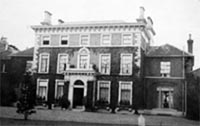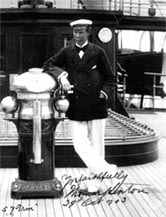Life Story of Sir Thomas Lipton
High Society

When Lipton transferred his business from Glasgow to his new London headquarters he also acquired a new home, Osidge, a large comfortable house set in a sixty acre estate in Southgate, Middlesex. He enjoyed entertaining friends and business acquaintances and every year he held a day of sports and entertainment especially for his office staff.
In 1898, Lipton purchased the Clyde-built 1,240 ton steam yacht, Aegusa, which he renamed the Erin. Lipton entertained lavishly on the Erin: "Looking back now it gives me intense satisfaction to recall the many prominent and distinguished people to whom I had the honour of acting as host aboard my floating home". (Lipton, p223)

Among his distinguished guests were King Edward VII, Queen Alexandra, Princess Beatrice and her daughter and "practically every Royal personage in Europe and of illustrious men and women in every walk of life on both sides of the Atlantic". (Lipton, p224)
In 1898 he travelled to the Isle of Wight to be knighted by the Queen. He became a baronet in 1902. Perhaps the greatest honour, however, was to be given the Freedom of Glasgow in 1923.
Sir Thomas, as a friend of Edward VII, found himself mixing with the cream of Edwardian society. He was a frequent guest at Buckingham Palace and Balmoral. At Cowes he was entertained on the royal yacht Victoria and Albert and in return he arranged cruises and parties on board the Erin. Ascot, the Cowes regattas, Christmas on the Riviera, royal parties at Sandringham, visits to Ceylon and the United States filled his social year.
His popularity in America increased with every visit. He mixed with everyone from Wall St to Washington, from New York Yacht Club to Hollywood. He dined at the White House and entertained President Roosevelt on board the Erin.
Lipton was wealthy, good-looking and affable and therefore particularly eligible. He was a "ladies man and an adept flirt" (Crampsey, p66) and there was never a shortage of the company of ladies. The newspapers, on both sides of the Atlantic, would take a "friendly curiosity" (Crampsey, p66) in his marital state but he remained unmarried all his life.
